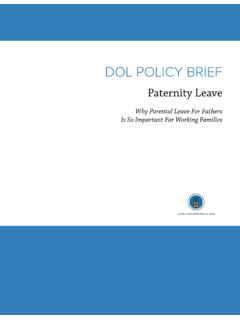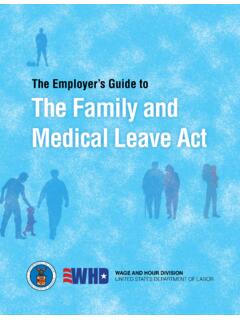Transcription of A GUIDE TO UK EMPLOYMENT LAW
1 A GUIDE TO UK EMPLOYMENT LAW CONTENTS Page A. INTRODUCTION 11. Sources of UK EMPLOYMENT law 12. Types of worker in the UK 23. UK EMPLOYMENT courts 3B. IMMIGRATION REQUIREMENTS 31. Overview 32. Work permit requirements 33. Work permit applications 44. Highly skilled migrant programme 65. The Science and Engineering Graduate Scheme 66. Employing illegal workers 6C. CONTRACTUAL TERMS 71. Overview 72. Express terms 73. Implied terms 94. Varying terms 10D. RIGHTS DURING EMPLOYMENT 101. Overview 102. Hours of work 103. Salary and benefits 114. Pensions 125. Holidays 136. Sick pay 137. Maternity leave 148. paternity leave 149. Adoption leave 1510. Parental leave 1511. Time off for dependants 1612. Flexible working 1613. Union membership 1714.
2 Data protection rights 1715. Disciplinary and grievance procedures 1916. Monitoring/surveillance 2017. Health and safety 2118. Whistleblowing 2219. The Protection from Harassment Act 1997 23E. TERMINATION OF EMPLOYMENT 231. Overview 232. Wrongful dismissal 233. Unfair dismissal 244. Dismissal procedures 265. Redundancy payments 286. Written reason for dismissal 287. Settling employees claims on termination 298. Enforcing post termination restrictions 29F. DISCRIMINATION 301. Overview 302. Sex discrimination 303. Equal pay 314. Race discrimination 315. Disability discrimination 326. Sexual orientation discrimination 337. Discrimination on the grounds of religion or belief 338. Part time workers 339. Fixed term workers 3410. Age Discrimination 35G.
3 BUSINESS TRANSFERS 351. Overview 352. Application of TUPE 353. Effect of TUPE 364. Information and consultation requirements 375. Occupational pension arrangements 386. Other proposed amendments to TUPE 38H. COLLECTIVE RIGHTS 391. Overview 392. Trade union recognition 393. Consultation on collective redundancies 404. Consultation on business transfers 415. Consultation on health and safety issues 426. Works Councils 427. National Works Councils 42 USEFUL WEBSITES 45 A. INTRODUCTION 1. SOURCES OF UK EMPLOYMENT LAW There are three main sources of UK EMPLOYMENT law: the common law, statute and European law (in the form of both European Directives and decisions of the European Court of Justice). Common law. Since all employees in the UK work under a contract of EMPLOYMENT with their employer, the common law (particularly the law of contract) forms the legal basis of the employer/employee relationship.
4 A contract of EMPLOYMENT need not be but is usually recorded in writing. The parties are free to stipulate which law will be the governing law of the contract. However, certain mandatory statutory EMPLOYMENT protection rights will apply regardless of the law of the contract. In addition, the law of tort will govern matters such as an employer s liability for the acts of its employees and liability for industrial accidents. Statute. Since the early 1970s there has been a dramatic growth in the amount of UK EMPLOYMENT protection legislation which has supplemented the common law rules. The main EMPLOYMENT law statutes are:- Equal Pay Act 1970 Health & Safety at Work etc Act 1974 Sex Discrimination Act 1975 Race Relations Act 1976 Trade Union and Labour Relations (Consolidation) Act 1992 Disability Discrimination Act 1995 EMPLOYMENT Tribunals Act 1996 EMPLOYMENT Rights Act 1996 Public Interest Disclosure Act 1998 Data Protection Act 1998 National Minimum Wage Act 1998 Human Rights Act 1998 EMPLOYMENT Relations Act 1999 EMPLOYMENT Act 2002 EMPLOYMENT Relations Act 2004 Disability Discrimination Act 2005 In addition, there is a substantial amount of secondary legislation in the form of regulations which contain further provisions which affect the EMPLOYMENT relationship.
5 In some cases the legislation is supported by Codes of Practice drawn up by various government agencies. Although the Codes do not have direct legal effect, they are often, and in some cases have to be, taken into account by EMPLOYMENT Tribunals when deciding whether an employer has complied with its statutory obligations. European law. If UK domestic law has failed properly to implement EC Treaty obligations, individuals may rely on the EC Treaty in the UK courts. EC legislation has been particularly important in the areas of equal pay, discrimination and employees rights on business transfers. In addition, since the European Court of Justice is the final arbiter in matters of interpretation of European legislation, its judgments are important when it comes to questions relating to the interpretation of obligations derived from European Directives. 1 GUIDE TO UK EMPLOYMENT LAW 2.
6 TYPES OF WORKER IN THE UK There have traditionally been three main categories of worker in the UK: self-employed independent contractors, agency workers or temps, and employees, with each category enjoying different EMPLOYMENT protection rights. In recent years, however, a fourth category, workers has been established. Confusingly, this category overlaps with the others. Independent Contractors. In essence, an independent contractor is someone who is in business on their own account and who is responsible for making their own decisions as to how the job is performed. There are advantages for both the employer and the individual in having a relationship of this nature; the employer is freed from most statutory EMPLOYMENT protection legislation, and the individual enjoys a favourable tax position. However, these types of relationship have come under increasingly closer scrutiny by the courts and HM Revenue & Customs (HMRC) (formerly the Inland Revenue).
7 The fact that an individual is labelled an independent contractor by both parties to the relationship is not the determining factor. Current decisions suggest that the most important considerations are whether there is mutuality of obligations and an obligation on the part of the contractor to do the work personally. If there is, then the court and/or HMRC is likely to find that the relationship is actually one of employer/employee. Agency Workers. Some workers are employed or engaged by an EMPLOYMENT agency which then supplies their services to the hirer. Although the hirer will owe certain statutory duties ( duties under the discrimination and health and safety legislation) it will not owe the agency worker many of the EMPLOYMENT protection rights enjoyed by employees. Agency workers are generally used for temporary engagements although it is not uncommon for engagements to last for several months or even years.
8 Case law has emphasised, however, that if an agency worker is used by a hirer for an extended period, and other facts point to an employer/employee relationship, the agency worker may be able to claim EMPLOYMENT rights directly against the hirer (even if there is no contract directly between the agency worker and the hirer). Employees. The majority of workers in the UK are employees of the company to which they provide their services. Unlike in some EU countries, there is no legal distinction between blue collar workers, white collar workers and senior directors, other than whatever may be written into their EMPLOYMENT contracts. The basic principles of the common law and statutory EMPLOYMENT protection legislation apply to all employees regardless of their status. As long as they satisfy the relevant qualifying conditions, employees will benefit from greater statutory EMPLOYMENT protection rights than independent contractors and agency workers.
9 In particular, after one year s service, an employee will benefit from the right not to be unfairly dismissed. Workers. The idea of a separate legal category of workers is a relatively new one in UK law. The concept derives from European law. In broad terms, a worker is someone who works under an EMPLOYMENT contract, or some other contract under which they agree to provide services personally. In addition, to qualify as a worker the organisation to which the individual is providing their services must not be a client/customer of their profession or business. So, for example, some independent contractors may qualify as workers. Workers enjoy fewer rights than full employees, but still benefit from, for example, rights relating to the number of hours they work, the amount of annual leave they can take, and the amount they are paid. 2 GUIDE TO UK EMPLOYMENT LAW 3.
10 UK EMPLOYMENT COURTS There are three forums which decide legal disputes between a worker and whoever employs them: EMPLOYMENT Tribunals, the common law courts (the High Court or County Court) and the recently introduced arbitration scheme operated by a government body called the Advisory Conciliation & Arbitration Service ( ACAS ). EMPLOYMENT Tribunals. These are specialist EMPLOYMENT courts which hear the majority of disputes which arise between employers and the staff they engage. They deal mainly with claims brought under the EMPLOYMENT protection legislation such as unfair dismissal and discrimination claims. They also have jurisdiction to hear contractual claims (subject to a maximum award of 25,000) provided the claim arises or is outstanding on the termination of EMPLOYMENT . EMPLOYMENT Tribunals usually comprise three members: a legally qualified chair and two lay members (one from a Trade Union background and one from a management background).






